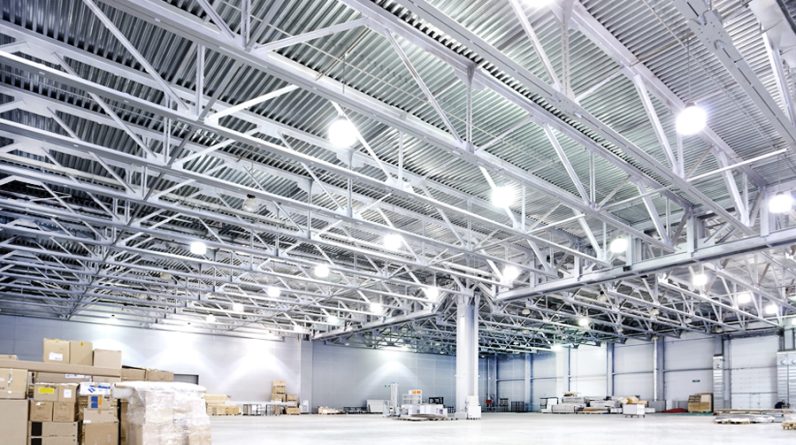
LED high bay lights are a type of lighting fixtures designed to provide bright and efficient lighting for industrial, commercial and large scale facilities. They are typically installed in high ceiling areas, such as warehouse, gymnasiums, large retail stores, and manufacturing facilities, where the ceiling height is over 20 feet.
LED high bay lights use Light Emitting Diodes (LEDs) as their light source, which are known for their energy efficiency, long lifespan, and low maintenance compared to traditional lighting technologies such as fluorescent or incandescent lights. LED high bay lights come in a variety of shapes, sizes, and designs, and can provide directional or omnidirectional lighting to suit the specific needs of a facility. They can also be dimmed or controlled by occupancy sensors or timers for further energy savings.
Why LEDs For High Bay Lights?
LEDs are a popular choice for high bay lighting for several reasons:
Energy Efficiency: LEDs are much more energy efficient than traditional lighting technologies, reducing energy costs and helping to lower the overall carbon footprint of a facility.
Long Lifespan: LEDs have a long lifespan, often lasting for many years before needing to be replaced. This reduces the frequency of maintenance and replacement required, saving time and money.
High Brightness: LED high bay lights can produce high levels of brightness, making them ideal for illuminating large industrial spaces and commercial facilities.
Durability: LEDs are known for their durability and can withstand harsh environments, making them suitable for use in industrial settings.
Flexibility: LED high bay lights can be designed in a variety of shapes, sizes and styles, providing flexible options for different ceiling heights and facility requirements.
Improved Light Quality: LEDs emit bright, high-quality light that can help to improve visibility, safety, and productivity in a facility.
Environmentally Friendly: LEDs do not contain hazardous materials such as mercury, making them an environmentally friendly lighting option.
In summary, the energy efficiency, long lifespan, high brightness, durability, flexibility, improved light quality and environmentally friendly characteristics of LEDs make them an ideal choice for high bay lighting applications.
What Are The Different Types Of LED High Bay Lights?
There are several types of led high bay lighting available on the market, each with its own set of unique features and benefits:
Linear LED High Bay Lights: These lights feature long, narrow fixtures that provide directional lighting, making them suitable for use in long, narrow spaces such as gymnasiums and warehouses.
Round LED High Bay Lights: These lights feature round fixtures that provide omnidirectional lighting, making them suitable for use in large open spaces such as manufacturing facilities and retail stores.
UFO Led High Bay Lights: These lights feature a circular or disc-like shape, making them a popular choice for industrial and commercial applications. They provide bright and efficient lighting and can be installed easily.
Slim LED High Bay Lights: These lights feature a sleek and compact design, making them suitable for use in facilities with limited space or low ceilings.
Explosion-Proof LED High Bay Lights: These lights are designed for use in hazardous or potentially explosive environments, such as oil refineries and chemical plants. They are built to withstand extreme conditions and are certified for use in these types of environments.
Smart LED High Bay Lights: These lights feature advanced controls and sensors that can be integrated with building management systems. They can be programmed to dim or turn off automatically when the space is not in use, reducing energy waste and costs.
These are some of the most common types of LED high bay lights, and choosing the right one will depend on the specific requirements of a facility. It’s important to consider factors such as ceiling height, lighting requirements, energy efficiency, and budget when choosing the right LED high bay lights.
Wattage And Lumens – How To Choose The Correct Amount?
When choosing the correct wattage and lumens for LED high bay lights, there are several factors to consider:
Ceiling Height: The higher the ceiling, the more light is needed to adequately illuminate the space. For ceiling heights of 20-25 feet, a minimum of 100-120 lumens per square foot is recommended. For ceiling heights over 25 feet, a minimum of 150-200 lumens per square foot is recommended.
Application: The type of activity or task being performed in the space will also determine the amount of light required. For example, spaces used for precise tasks such as assembly lines will require more light than spaces used for general storage.
Color Rendering Index (CRI): A high CRI means that the light accurately represents the true colors of objects in the space. A CRI of 80 or higher is recommended for most applications, while a CRI of 90 or higher is recommended for color-critical tasks.
Energy Efficiency: Choosing a LED high bay light with higher lumens per watt ratio will result in greater energy efficiency and lower operating costs.
Room Size: The size of the room or space being illuminated will also determine the number of LED high bay lights required and the total wattage needed.
As a general rule, a 400-watt LED high bay light can provide approximately 45,000-50,000 lumens, while a 200-watt LED high bay light can provide approximately 22,000-25,000 lumens. It is important to consult with a lighting professional to determine the exact amount of lumens and wattage needed for a specific application.
How To Calculate Lux?
Lux is a measure of the amount of light that falls on a surface, and it is calculated as follows:
Lux = (Light Intensity) / (Surface Area)
Where Light Intensity is the amount of light (measured in lumens) emitted by a light source, and Surface Area is the area of the surface being illuminated (measured in square meters).
To calculate lux, you need to know the amount of light emitted by the light source (in lumens) and the surface area being illuminated (in square meters). For example, if a 400-watt LED high bay light produces 50,000 lumens and is illuminating a surface area of 100 square meters, the calculation would be:
Lux = (50,000 lumens) / (100 square meters) = 500 lux
It is important to note that the lux level required will depend on the specific application and the type of task being performed. For general office or commercial spaces, a lux level of 300-500 lux is typically recommended. For tasks that require high levels of detail, such as reading or fine assembly work, a lux level of 800-1000 lux or higher is recommended.
It is always best to consult with a lighting professional to determine the correct lux level for a specific application, as there are many factors that can impact the amount of light needed, such as the ceiling height, color rendering index (CRI), and the type of activity being performed in the space.





